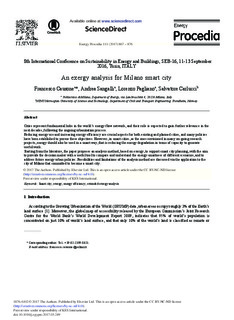| dc.contributor.author | Causone, Francesco | |
| dc.contributor.author | Sangalli, Andrea | |
| dc.contributor.author | Pagliano, Lorenzo | |
| dc.contributor.author | Carlucci, Salvatore | |
| dc.date.accessioned | 2017-04-10T11:08:23Z | |
| dc.date.available | 2017-04-10T11:08:23Z | |
| dc.date.created | 2016-07-07T14:05:16Z | |
| dc.date.issued | 2017 | |
| dc.identifier.citation | Energy Procedia. 2017, 111 867-876. | nb_NO |
| dc.identifier.issn | 1876-6102 | |
| dc.identifier.uri | http://hdl.handle.net/11250/2437307 | |
| dc.description.abstract | Cities represent fundamental hubs in the world’s energy-flow network, and their role is expected to gain further relevance in the next decades, following the ongoing urbanization process. Reducing energy use and increasing energy efficiency are crucial aspects for both existing and planned cities, and many policies have been established to pursue these objectives. However, in smart cities, as the ones envisioned in many on-going research projects, energy should also be used in a smart way, that is reducing the energy degradation in terms of capacity to generate useful work. Starting from the literature, the paper proposes an analysis method, based on exergy, to support smart city planning, with the aim to provide the decision maker with a useful tool to compare and understand the energy-smartness of different scenarios, and to address future energy urban policies. Possibilities and limitations of the analysis method are discussed via the application to the city of Milano that committed to become a smart city. | nb_NO |
| dc.language.iso | eng | nb_NO |
| dc.publisher | Elsevier | nb_NO |
| dc.relation.uri | http://ac.els-cdn.com/S1876610217302825/1-s2.0-S1876610217302825-main.pdf?_tid=82be8884-1b8f-11e7-b418-00000aab0f6c&acdnat=1491569064_ce80d99cc7483210e69e961a78991315 | |
| dc.rights | Attribution-NonCommercial-NoDerivatives 4.0 Internasjonal | * |
| dc.rights | Attribution-NonCommercial-NoDerivatives 4.0 Internasjonal | * |
| dc.rights.uri | http://creativecommons.org/licenses/by-nc-nd/4.0/deed.no | * |
| dc.rights.uri | http://creativecommons.org/licenses/by-nc-nd/4.0/deed.no | * |
| dc.subject | Energieffektivisering | nb_NO |
| dc.subject | Energy efficiency | nb_NO |
| dc.subject | Extended exergy analysis | nb_NO |
| dc.subject | Smart city | nb_NO |
| dc.subject | Exergy | nb_NO |
| dc.title | An exergy analysis for Milano smart city | nb_NO |
| dc.type | Journal article | nb_NO |
| dc.type | Peer reviewed | nb_NO |
| dc.subject.nsi | VDP::Bygg-, anleggs- og transportteknologi: 532 | nb_NO |
| dc.subject.nsi | VDP::Building, construction and transport technology: 532 | nb_NO |
| dc.source.pagenumber | 867-876 | nb_NO |
| dc.source.volume | 111 | nb_NO |
| dc.source.journal | Energy Procedia | nb_NO |
| dc.identifier.doi | 10.1016/j.egypro.2017.03.249 | |
| dc.identifier.cristin | 1366797 | |
| dc.description.localcode | © 2017 The Authors. Published by Elsevier Ltd. This is an open access article under the CC BY-NC-ND license | nb_NO |
| cristin.unitcode | 194,64,35,0 | |
| cristin.unitname | Institutt for bygg, anlegg og transport | |
| cristin.ispublished | true | |
| cristin.fulltext | original | |
| cristin.qualitycode | 1 | |

